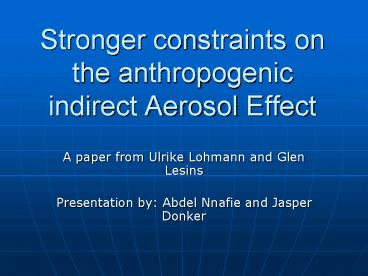Stronger constraints on the anthropogenic indirect Aerosol Effect - PowerPoint PPT Presentation
1 / 13
Title:
Stronger constraints on the anthropogenic indirect Aerosol Effect
Description:
8 months of space-born measurements are done by the Polder satellite. ... The outcomes of simulations are compared with the data from the POLDER satellite ... – PowerPoint PPT presentation
Number of Views:304
Avg rating:3.0/5.0
Title: Stronger constraints on the anthropogenic indirect Aerosol Effect
1
Stronger constraints on the anthropogenic
indirect Aerosol Effect
- A paper from Ulrike Lohmann and Glen Lesins
- Presentation by Abdel Nnafie and Jasper Donker
2
Contents
- Introduction
- Observations by Polder satellite
- Model
- Results
- Conclusion
- About the paper
3
Introduction
- The amount of aerosol in the atmosphere has
increased due to human activities - Direct effect this concerns scattering,
absorption and reflection of solar radiation by
cloud - Indirect effect aerosol act as cloud
condensation nuclei, thereby affecting the
initial cloud droplet number concentration (CDNC) - ?increase in cloud albedo (cloud albedo effect)
- ?reductions in precipitation efficiency and
increase of cloud lifetime (cloud lifetime
effect) - Cooling from these two effects causes a radiative
forcing between -1 and -4.4 W/m2 (this great
range causes large uncertainties in projections
of future climate change) (IPCC) - The anthropogenic indirect aerosol effect (aie)
cannot be deduced from observations along but
require a modeling component. - Historical climate data together with simulations
constrain this effect to a range of 0 to -1.2
W/m2. - In this paper a model is used for a more accurate
study of the anthropogenic indirect aerosol
effect, by using satellite observations
4
IPCC
5
Observations by Polder satellite
- 8 months of space-born measurements are done by
the Polder satellite. - These data were used to derive aerosol
concentrations and cloud droplet effective radii
(CDR). - Results the cloud droplet size decreases with
increasing aerosol index (AIthis represent the
aerosol column number concentration) - These data are not sufficient to quantify the
magnitude of the global indirect aerosol effect.
6
Model
- The ECHAM4 general circulation model is used in
this research. - 4 different simulation have been made
- Reference simulation ECHAM-CTL (includes both
indirect effects) - Simulation ECHAM-2ND-AIE (without the albedo
effect) - Simulation ECHAM-NO-AIE (without the aerosol
indirect effect) - Simulation ECHAM-PI (Pre Industrial simulation
without anthropogenic aerosol) - The outcomes of simulations are compared with
the data from the POLDER satellite
7
ResultsAI
8
ResultsCDR
9
Question?
- Do we need the anthropogenic aerosol indirect
effects to explain the observed anticorrelation
between AI and CDR? - Or is this anticorrelation only determined purely
by geographic variations in the liquid water
path?
10
- Oceanic slope is larger
- Polder oceanic and continental CDR converge
approximately toward - same limit (8 µm)
- Both aerosol indirect effects are needed to
reproduce the outcomes - of POLDER
- ECHAMs clouds are more susceptible to aerosols
than the observed clouds - ?ECHAM very likely overestimates the IAE.
- Oceanic slope overestimation 25.9/19.9 1.30
- Continental slope overestimation 21.6/7.00 3.09
11
- With increasing AI CDR decreases and the liquid
water path increases - ?detection of anthropogenic AIE from observation
only is complex - ?using models together with observations is
important.
12
conclusions
- The climate model simulations including -1.8
W/m2. - ?longwave radiation 1.4 W/m2.
- ? net decrease 1.4 W/m2.
- ECHAM simulates an aerosol effect of -1.28 W/m2
over oceans - After correction -0.98 W/m2.
- Over land this is -1.62 W/m2 ? after
correction -0.53 W/m2. - NET GLOBLA MEAN -0.85 W/m2.
- This value is consistent with of 0 to -1.2 W/m2.
13
About the paper































